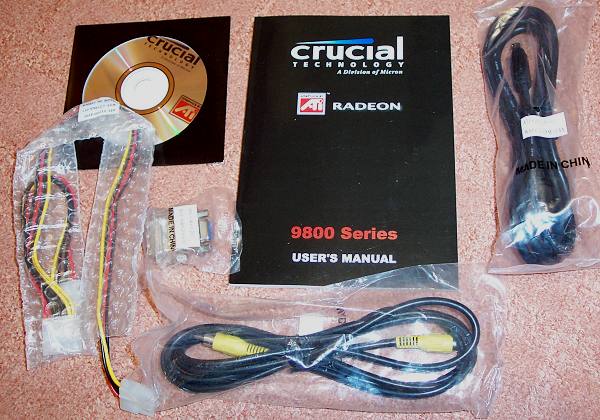Bundle and specs.
Packaging was an area that Crucial has never paid much attention to. The reasoning is simple enough. Crucial sells the bulk of its video cards via the internet. They don't need flashy boxes and fancy artwork to lure the customer.
Even Crucial has bowed down to the style gods. The card's most impressive features are listed, which, according to the blurb, offers "256-bit supercharged memory interface" and "superior 3D performance". And with NVIDIA still fumbling around with its DX9 implementation, those words do ring true.

The downside of previous Crucial cards has always been the bundle. It's no different here. Crucial's marketing thought is to price its cards aggressively, exploit its enviable position as an excellent customer-focussed company, and skimp on gaming-related extras. My personal viewpoint is that at least one decent game should be included. This is not a budget video card by any stretch of the imagination, yet you'd think so from the supplied bundle. Crucial does offer a limited lifetime warranty. That's actually worth something with Crucial's first-rate service.
The 9800 Pro 256MB, in graphics card terms, has been around for a while now. The driver / resource CD illustrates this point perfectly. Catalyst 3.2 (6307) drivers were included. We're now on Catalyst 4.1 - approximately 10 iterations of drivers separate the supplied and current set. We'd prefer it if Crucial updated its software periodically. The CD also contained a copy of WinDVD and Crucial's in-house overclocking utility.

It's kind of ironic that the utility wouldn't recognise the card. A fresh installation of Windows XP Professional (SP1) and the Catalyst 4.1 driver set is a good a base as any. The CD also lacked any versions of DX9. If nothing else, Crucial could bundle in the 10 or so DX9-heavy technology demos that ATI has released. The manual, though, is pretty slick.
How does it compare ?
To understand the relative positioning of the card, we sought to compare it to the Radeon 9800XT and NVIDIA GeForce FX 5950 Ultra. All three cards use 256MB of onboard memory.
| Name | Radeon 9800 Pro 256MB | Radeon 9800XT 256MB | GeForce FX 5950 256MB |
| GPU Name | R350 | R360 | NV38 |
| Engine speed | 380MHz | 412MHz | 475MHz |
| Rendering pipelines | 8 | 8 | 4* |
| Pixel fillrate | 3040MP/s | 3296MP/s | 1900MP/s |
| Texturing units | 1 | 1 | 2 |
| Texel fillrate | 3040MT/s | 3296MT/s | 3800MT/s |
| Memory speed | 700MHz | 730MHz | 950MHz |
| Memory bus width | 256-bit | 256-bit | 256-bit |
| Theoretical bandwidth | 22.4GB/s | 23.36GB/s | 30.4GB/s |
| Manufacturing process | 0.15-micron | 0.15-micron | 0.13-micron |
Consider the Crucial 9800 Pro 256MB as a pared-down version of the 9800XT. The XT adds in a few tweaks and optimisations other than clock speed increases, but those are only exposed in selective benchmarks. What we can guesstimate before benchmarking is that the Crucial card should perform to around 90% of the level attained by the 9800XT. The unknown performance is the 5950 Ultra's.









